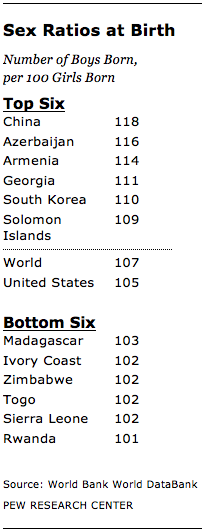
Research over hundreds of years has consistently found that boys naturally outnumber girls at birth. The speculation is that this is nature’s way of countering the relatively high mortality rates of males, and creating more of a gender balance in the population. While historically, there have been about 105 boys born for every 100 girls worldwide — which creates a “sex ratio at birth” of 1.05 — the share of boy babies has increased in recent decades. 2011 data from the World Bank show the global sex ratio at birth is now 1.07, or 107 boys born for every 100 girls.
 This increase in the sex ratio is driven largely by births in China, where sex ratios have declined slightly in recent years but remain the highest in the world. The world’s most populous country has 118 boys for every 100 girls, and accounts for 12% of births worldwide. However, disproportionately large shares of baby boys are found in other countries scattered throughout Asia and the Caucasus, as well. Azerbaijan, Armenia, Georgia, South Korea, and the Solomon Islands round out the list of places with the highest sex ratios. India is tied with Macedonia, Montenegro, Papua New Guinea, Samoa, Serbia and Suriname for 7th place, with a ratio of 108 boys born for every 100 girls.
This increase in the sex ratio is driven largely by births in China, where sex ratios have declined slightly in recent years but remain the highest in the world. The world’s most populous country has 118 boys for every 100 girls, and accounts for 12% of births worldwide. However, disproportionately large shares of baby boys are found in other countries scattered throughout Asia and the Caucasus, as well. Azerbaijan, Armenia, Georgia, South Korea, and the Solomon Islands round out the list of places with the highest sex ratios. India is tied with Macedonia, Montenegro, Papua New Guinea, Samoa, Serbia and Suriname for 7th place, with a ratio of 108 boys born for every 100 girls.
Even while some countries seem to have a disproportionate share of boys, others have particularly high shares of baby girls. While there are still slightly more boys born than girls in these places — which are centered in sub-Saharan Africa — the sex ratios are nonetheless much lower than average. The six countries with the lowest sex ratios include: Rwanda, Sierra Leone, Togo, Zimbabwe, Ivory Coast, and Madagascar.
So what explains these differences in the shares of baby boys and girls?
Perhaps the best-known reason relates to the practice of sex-selective abortion, which has been identified in Asia, and in the Caucasus, as well. The ability to determine fetal sex, along with strong son preferences, accounts in large part for the high shares of boys in many countries in these regions. The desire to limit family size, either due to government regulations as in China, or due to global social and economic changes that have reduced the need for large families, seems to further contribute to sex-selective abortion and a dearth of baby girls.
But this is only one of myriad factors that may be affecting the sex ratio at birth. Some research suggests that the share of newborn boys declines with older parents, and that the high share of girls in Sub-Saharan Africa may be linked to the practice of polygamy (multiple wives). What do these two phenomena have in common? Researchers hypothesize that both situations are associated with less frequent intercourse. (For possible explanations of this association, see this article from the academic journal Human Reproduction.)
On the opposite end of the spectrum, most research shows that the share of baby boys increases during and after wartime. And once again, frequency of intercourse is cited as the likely reason, at least in the case of post-war reunions.
In some cases, though, wartime is associated with a higher share of girl babies. This may relate to the fact that heightened maternal stress, such as would occur during wartime, can lead to an increased likelihood of a miscarriage which is more likely to occur among male fetuses.
Further evidence of this association between maternal stress and the increased share of girl babies emerges from an analysis of births in the vicinity of the Kobe earthquake in Japan, which showed that the share of females born nine months after that event was significantly higher than would have been expected under normal circumstances.



